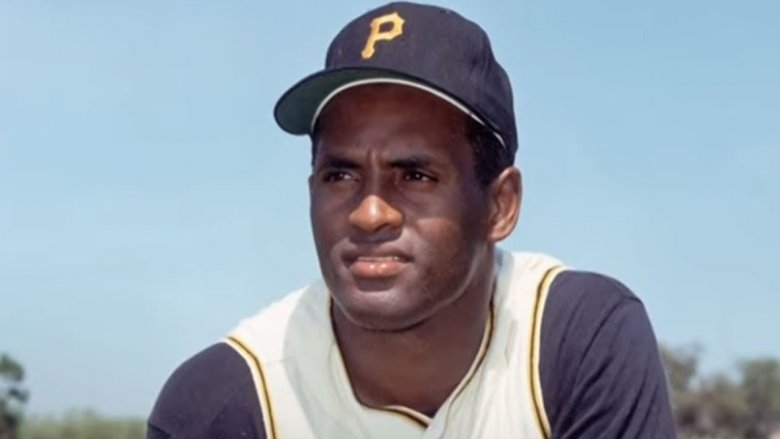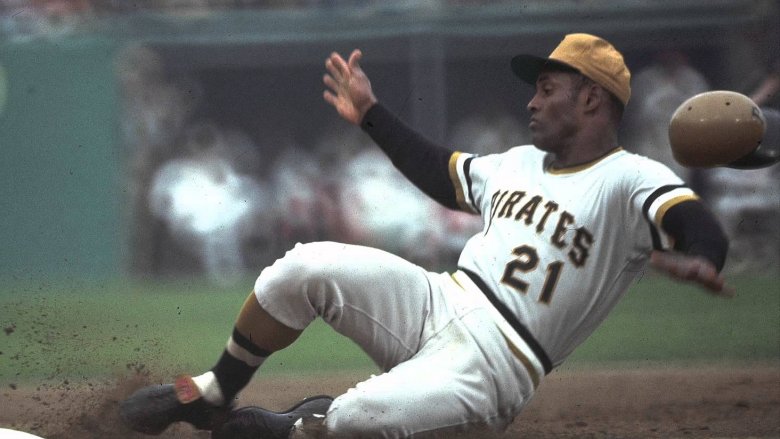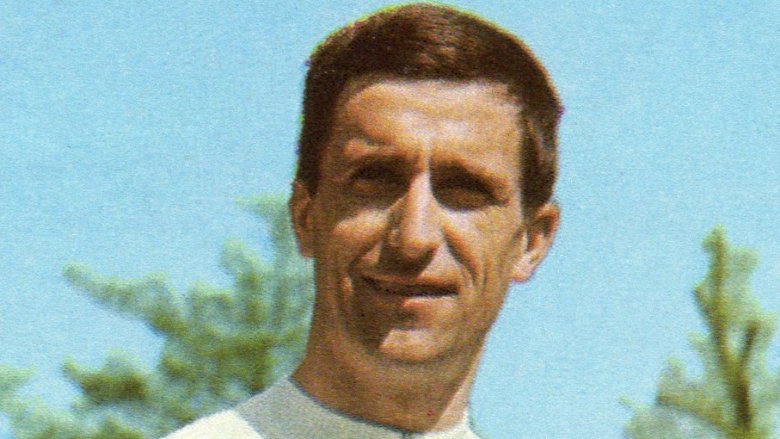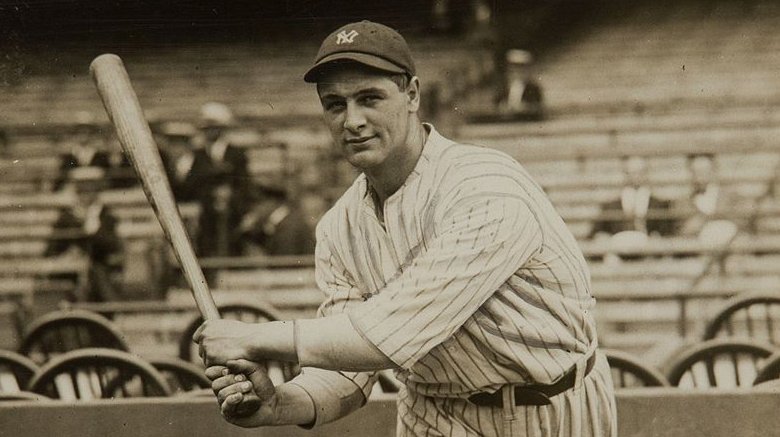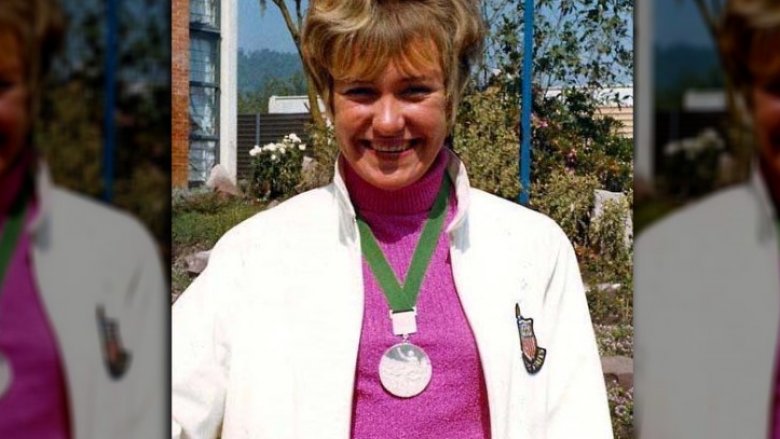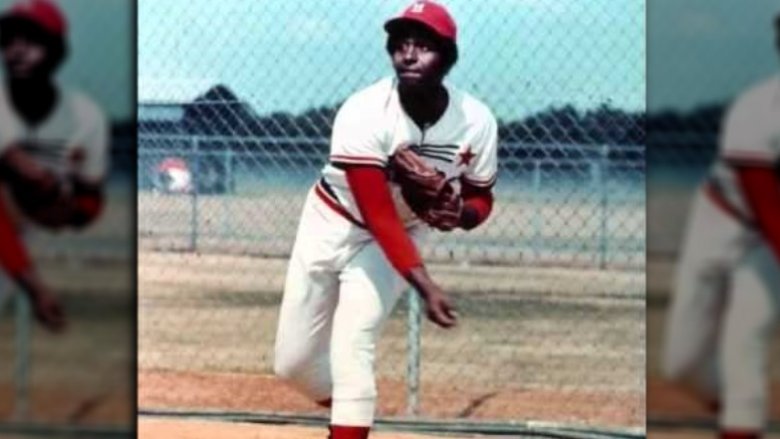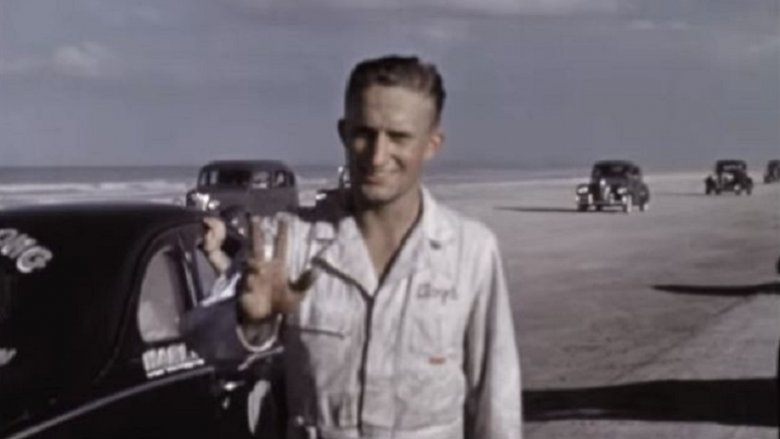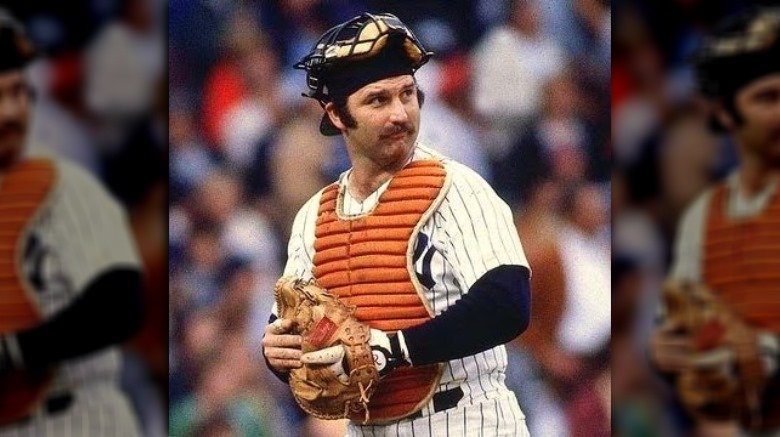Sports Stars Who Died Right At The Peak Of Their Fame
Given that the entire premise of sports is human beings pushing their bodies to the absolute limit, it's kinda surprising that every major season doesn't end with pitches, rings, courts, and tracks full of shattered limbs and the disapproving faces of the dead. But that's all part of the joy in watching sports stars competing. If the average American wanted to see an overweight dude suffer a massive coronary trying to shoot baskets, they would construct a court made of highly reflective glass and give themselves a show.
But even in the tightly controlled world of professional sportspeople, accidents do happen, both on and off the field. Sometimes, they can even happen to the very best. Old legends (plus Bill and Ted's Bogus Journey) may assure us that Death is willing to play chess for our mortal souls. Judging by the following, though, Death clearly ain't up for wagering on sports stars.
Davey Allison died in NASCAR's least predictable crash
It may not have been too surprising initially when Davey Allison died in a crash. He was a NASCAR driver and the son of the great Bobby Allison, who retired in 1988 after a near-fatal car crash, and brother of Clifford Allison, who died in a crash in a 1992 practice race (via Britannica). The type of crash that killed Davey, though, wasn't the one people had probably been worried about. On July 12, 1993, Allison was piloting his helicopter into the Talladega Superspeedway when something went wrong and he did the aerial equivalent of a belly flop. At the time the god of crashes claimed his soul, Allison was 32 and on the verge of becoming the biggest race car driver in the country.
Allison's '92 season had been the NASCAR season that young NASCAR fans dream of having. Under team chief Larry McReynolds, Allison had stacked up win after win after win. As '93 rolled on, he was looking like a dead cert for the Winston Cup. Add in his familial link to one of the best drivers of the '80s, and Allison was clearly on his way to becoming a NASCAR legend. And then he decided to try flying a helicopter.
The LA Times reported that thousands came out to line the route of his funeral, including hundreds of cars stretching for miles and miles. Thankfully for all concerned, this particular gathering of racing drivers resulted in absolutely no crashes.
Roberto Clemente died playing the Good Samaritan
Roberto Clemente was the Puerto Rican Jackie Robinson. In fact, forget that. He was Robinson, plus Babe Ruth, plus Lou Gehrig, plus anyone else you care to mention, all rolled into one and sprinkled with a dusting of Mother Teresa. A lifelong player for the Pittsburgh Pirates, Clemente smashed down barriers for Latino baseball players with almost as much force as he smashed balls into the stratosphere.
As Clemente's page on History details, he won "12 Golden Gloves and four National League batting titles," all while posting a batting average of .317. If you don't follow baseball, just imagine that last sentence read "all while being really, really good at all parts of baseball" and you'll get the general drift. Yet, for all his sporting prowess, Clemente was equally famous off the field for his charity work. As the anti-poverty Borgen Project notes, the baseballer spent his down time coaching underprivileged youth in Puerto Rico and heading up charity relief efforts in Latin America. In one of those twists of fate that make you wonder if God is a total meanie, it was this charity work that would get him killed.
Just before Christmas 1972, Nicaragua was hit by a catastrophic earthquake. Ten thousand lives were ended, and the capital of Managua was flattened. Despite being at the height of his career, Clemente headed up relief efforts, including personally flying out on a cargo plane. On New Year's Eve, that plane went into the sea. Clemente's body was never found.
Tom Simpson's tragic death showed cheaters never prosper
There's a good argument to be made that Tom Simpson was Britain's greatest cyclist. There's also a parallel argument that he was Britain's biggest drug cheat. During his long career, Simpson was stuffing so many amphetamines into his body that geneticists could probably conclude he was 90 percent Keith Richards. Not that anyone knew this at the time. As the epitaph to his monument on Mont Ventoux reads, he was known as an "Olympic medallist, a world champion, a British sporting ambassador." It wasn't until he dropped dead on that very spot, aged 29, that the truth was discovered.
The year was 1967, and Simpson was riding the 13th stage of the Tour de France. Just five years before, he'd become the first Brit to ever wear the fabled yellow jersey (via The Telegraph). In the meantime, he'd also become the first British road race world champion, BBC sports personality of the year, and the winner of a galaxy of smaller races, titles, and trophies. He'd also turned his bloodstream into a steady flow of alcohol and speed. Pro tip: Booze, pills, and hard riding do not make happy bedfellows.
Simpson was nearing the summit of Mont Ventoux when he appeared to have suffered a massive heart attack and fell from his bike after veering across the road. So determined was he to win that he begged to be put back on his bike. After a short distance more, his bike began to wobble. He was held up by spectators, who discovered that he was already pretty much dead, his hands locked onto his handlebars. They escorted him to the side of the road and laid him down. This time, he didn't get up.
Lou Gehrig gave his name to the disease that killed him
Baseball legend Lou Gehrig was so famous when he died that the disease that killed him, ALS, is still known popularly as Lou Gehrig's disease. That's an ... honor, probably? Regardless of any unintentional ghoulishness, the naming at least shows what sort of man Gehrig was in 1941: a guy so well-known that if he'd been shot to death we'd probably all be loading our rifles with "Lou Gehrig's bullets" today. Remarkably for a sportsman, that level of fame was reached after he'd passed his physical peak (via Biography).
You know how guys like Freddie Mercury became even more famous after dying a lingering death? That was basically how Gehrig's fate played with people in the 1940s. They saw him go in two years from a great baseball player to a man incapable of even tying his own shoelaces. The change was so shocking, and so sudden, that everyone with even a vague interest in sports took notice. When Gehrig was forced into early retirement by his illness in 1939, people were so moved that they came in droves to watch him give a famous farewell speech that was all kinds of touching. When he died two years later, his number was the first to be retired in baseball history.
There's a minor twist to this story. In 2010, Wired reported on research suggesting Gehrig may not have actually had ALS. So that's how famous Gehrig was: Even diseases he possibly didn't have wound up named after him.
Lillian Board conquered the Olympics but was defeated by cancer
In 2006, the London Telegraph described British sprinter Lillian Board as a "golden girl not so much touched by stardust as smothered in the stuff," a description that shows how potent her memory still is decades after her death. Board had exploded onto the athletics scene at the 1968 Mexico City Olympics, pulling in a silver medal in the 400 meters at the age of 19. The next year, she'd nabbed a gold in the European Championships 800 meters and been part of the winning U.K. team in the 400-meter relay. Basically, she was as hot as a jet of sentient magma, with a burning desire to win that made her the darling of British sport. Everyone knew she'd get gold at the 1972 Olympics. Everyone was wrong.
Just as she was becoming Britain's top female sports star, Board started developing weird back pains. Since this is an article about sportspeople dying young and all, you can probably hazard a guess as to what those pains were. Yep, Board was developing a nasty form of bowel cancer, diagnosed in 1970. As this BBC obituary recalls, by the end of the year she was dead. She died on December 26, two years shy of the Olympic Games she was supposed to conquer. She was 22.
At least some good did come out of Board's early death. To this day, Cancer Research UK awards the Lillian Board trophy for the highest amount of money raised through endurance events.
Don Wilson's bizarre death is still baffling
At the start of January 1975, Don Wilson was famous as a pitcher in the Houston Astros, a player who was inconsistent, but capable of kicking insane amounts of backside. Soon, Wilson would be famous for a far less happy reason. On January 5, he died in a mysterious accident/possible suicide/possible murder (via Houston Chronicle).
As baseball blog Seamheads details, Wilson was a pitcher who could've been up there with the greats. All the way back in 1965, when Wilson was 19, people were remarking on his mysterious ability to make the ball do whatever he wanted. By the time he hit the big leagues, he was throwing pitches that defied the rules of physics, weaving and curving like something out a game of Quidditch. He was also famous off the pitch, for a cringey 1960s Deep South reason: He was friends with a white teammate and they sometimes roomed together. Gasp!
Now for the disturbing part. On the afternoon of January 5, police responded to Wilson's garage to find the athlete slumped inside his car, dead from carbon monoxide poisoning, his bloodstream full of alcohol. His son, Alex, whose room was above, was also dead, while his wife and daughter were critically ill and his wife had an injured jaw she couldn't explain. Officially, the pitcher's death was ruled an accident, but rumors persist of suicide or a domestic dispute turned deadly. Whatever the cause, Wilson's number was retired.
Lloyd Seay was NASCAR's greatest driver before NASCAR even existed
Officially, Lloyd Seay competed in only a handful of races in his lifetime. Unofficially, his life was one long race, gunning it away from the long arm of the law while jaunty chase music presumably played in the background. Before he turned professional racer, Seay was a professional bootlegger in Georgia, and his life reads like a Dukes of Hazzard prequel. Sheriffs told stories about how Seay sometimes paid his speeding fines upfront to save time when he was gunning back from a moonshine sale.
Today, Seay is known as NASCAR's "greatest driver who wasn't" (via SB Nation Atlanta), for the excellent reason that he died six years before NASCAR existed. But that doesn't mean people didn't notice him. In later life, NASCAR founder Bill France, who started out on the smaller circuits, would say "Seay was the best pure race driver I ever saw." That's how good he was. Some 50 years after his death, a guy who had seen thousands upon thousands of drivers race in the years since still held Seay as the master. Talk about leaving a lasting impression.
Even in 1941, people knew Seay was destined for great things. In his first big season, he won the Daytona Beach Road Course, the High Point Speedway, and the Lakewood Labor Day event within 15 days of one another. He was just starting to get noticed on the national stage when he got in an argument with a cousin over money and was shot dead, aged 21.
Samia Omar broke down barriers then died crossing the biggest
A sprinter from Somalia, Omar was one of only two athletes the war-ravaged nation sent to the 2008 Beijing Olympics. Desperately underequipped, Omar nonetheless qualified for the 200-meter dash. Aged 17, she stood on the starting block in her loose T-shirt, donated sneakers, and black leggings, and watched as the lycra-clad superwomen of countries not at war proceeded to disappear in a cloud of dust. Omar placed last, by several seconds. But the crowd didn't care. Seeing how hard the teenager was trying, they gave her the biggest cheer of the entire night.
Despite its viral-ready factor, Omar was embarrassed by the applause. A Guardian profile explains the race made her realize how poor training was back in Somalia, and she returned determined to improve things for the 2012 Games. Sadly, her future would turn out to be far less uplifting than this Disney-ready setup might suggest.
Although she was famous back home, Omar found herself by 2010 living in a displaced persons camp after militant group al-Shabaab overran Mogadishu. Since letting women do literally anything isn't really in the crazy jihadist playbook, Omar decided to make a break for Europe, hoping to get the training she craved. She spent a year being smuggled from Somalia to Libya, finally boarding a boat bound for Italy in spring 2012. She never made it to the London Games. Omar drowned en route to Europe, just one of many migrants to drown on the voyage.
Thurman Munson fell to Earth in the most brutal way possible
If you're a Yankees fan, just reading the name Thurman Munson can send a shiver down your spine. Possibly the greatest catcher of the 1970s, Munson racked up accolades like most people rack up wrinkles and receding hairlines. As SB Nation writes, he was a seven-time All-Star. A three-time Golden Glove winner. A two-time champion. A one-time Most Valuable Player. If you took all Munson's awards and stacked them on top of one another, you'd need a light aircraft to fly over them. Which brings us to the thing that ended Munson's career: a plane crash.
On August 2, 1979, Munson was perhaps the most famous Yankee of all. On that hot, sultry day, he took off in his plane to show off his piloting skills for two friends. At that point, Munson had been flying for a year and a half and was on his fourth plane. Unfortunately, he was not as good a pilot as he thought he was.
While practicing touch-and-go landings, Munson unintentionally stalled the plane and crashed into some trees. Although he survived the crash, he didn't survive the subsequent fire. Shattered, burned, and broken, Munson died of smoke inhalation before help could arrive. (The two passengers lived.) His death was so shocking that the Yankees left his locker untouched until their stadium was demolished in 2010.
Plum Mariko died doing the sport she helped make famous
A founding member of Japan Women's Pro Wrestling (JWP), Plum Mariko was once one of the biggest sports stars on the Asian scene. Fan site Quebrada remembers her as a "Submission Queen," which is way less Fifty Shades than you're imagining and more an indication of how powerful she could be in the ring. Although she played second fiddle to bigger names like Cuty Suzuki, Plum was still a big enough draw to headline shows. After a period away from the ring in the '90s due to injury, she returned looking like her star could finally go supernova, if only she could get over some gaps in her memory and strange headaches she kept having.
Although she wasn't aware of it, Plum was suffering from the effects of brain damage, the result of a lifetime of being smashed head-first into a mat by people with names like Command Bolshoi. Supposedly, she didn't tell JWP about her problems, fearing they'd retire her. As you're about to see, that's exactly what they should have done.
On August 15, 1997, Plum was hit with Mayumi Ozaki's finishing move "the Ligerbomb," the wrestling equivalent of having a 10-ton truck go to town on your soft, fleshy body. No one is quite sure if the move went wrong or if it just triggered something that was going to happen regardless, but Plum hit the mat and didn't get up. No prizes for guessing why not. At the time Plum checked out, she wasn't even 30.
